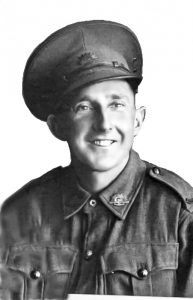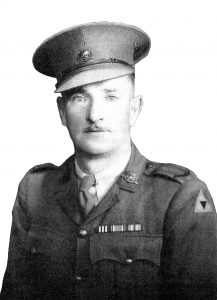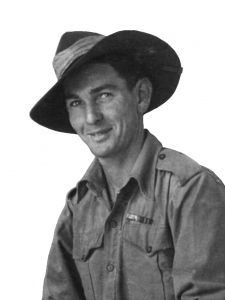23 YEAR OLD RUPE MILLHOUSE WAS ONE OF 15 AUSTRALIAN PRISONERS HELD IN A SMALL ROOM AT JAPANESE HQ, at BUKIT TIMAH ON 19 FEB 1942.
During the fighting in Singapore on 11th Feb 1942, SRB had crossed through scraggy bush land and entered a basin shaped piece of land without vegetation, they could see native huts at the end of the clearing. They had hours earlier, in great haste evacuated their last position which was overrun by Japanese soldiers.
Suddenly all hell broke out – SRB, plus one Indian and one British Company walked straight into a Japanese ambush.
Officers managed to yell sufficient orders to a large number of soldiers to form a bayonet charge against the Japanese machine guns located ahead in the huts and to the sides. Soldiers were falling either KIA and wounded. The Indians panicked. Those at the rear realised their best chance of surviving was to run from the shooting.
Those left behind Japanese line sought safety in the scrub. Most were hunted down and killed.
Les McCann with a wounded leg sought safety in a native hut where he found 2 wounded British officers and an Indian soldier – together they tumbled into a dugout shelter beneath the hut and waited in silence.
The four men spent at least a night if not two before McCann took a gamble and poked his head out of the below ground shelter – they had had nothing to eat or drink. Les was in luck, he immediately spied a demijohn on the other side of the hut and quickly crawled over and grabbed the container, some coconuts and a few pieces of food before disappearing out of sight. They were able to wash their wounds.
The following morning McCann decided to venture outside and further away into the nearby native village. As he carefully crept between huts he heard a voice call out. It was Rupe Millhouse from his Platoon. Rupe was seriously wounded with four GSW in his knee and unable to walk at all. McCann immediately dressed his wound, found a rifle to use as support the two men quickly returned to the underground shelter and interim safety.
The British and Indian soldiers decided they would leave the next morning, take a chance and head for the coast. Millhouse was in great pain and in no condition to walk. He and McCann decided to stay for what would be another two nights during which time McCann cleaned and dressed Rupe’s wounds, fed and watered him.
With no clue of what was ahead Millhouse and McCann left the shelter and began walking towards Singapore. It was 14 Feb 1942. They saw a few elderly native women with young children, even a Japanese convoy. It rained again and they took rest in the first kampong hut they came across. In the morning two monks came by and advised them the war was over and the Japanese wanted all soldiers to quickly return to Singapore and showed them the direction of the coast road. They came across an Australian Naval man who advised them to abandon their weapons – he was travelling north intending to escape.
16th February McCann and Millhouse moved out again along West Coast Road where they met 3 other Australians near Pasir Panang Village. The 5 men were stopped by Japanese sentries standing outside an arched building and ushered inside. They were then locked in a room fitted with barred windows. At about 1800 hours that evening they were taken outside and put on a truck. At the gate they met another Japanese who was escorting more Australians including R.S. Fred Airey and Private Harold Ockerby; the remainder were all members of 2/28th Battalion. The group no numbered 15. R.S.M. Airey had been conscripted from. Singaporeto drive trucks for the Japanese for the purpose of collecting Japanese bodies to be taken to the crematorium.
Below: WX7736 Private HAROLD BERTRAM OCKERBY died aged 42 years. A WW1 veteran Ockerby had been Driver to 2/4th Battalion’s CO Lt. Col Anketell.

It was five days after the Allies had surrendered to Japan. The previous day the prisoners had been questioned one by one and returned to their ‘cell’.
On 19 February, the 15 Australian prisoners were called out of their room/cell one by one, each had their hands tied behind their backs with hessian, and then ordered to march.
First past the jeering Japanese soldiers who had shown nothing but contempt for the Australian soldiers. They were especially bitter towards the machine gunners who had fought them to the end.
They were ordered to march towards remote scrubland until they reached a creekbed. Here they were ordered to line up, turn their backs towards the Japanese (7 soldiers).
It was probably at this point the Australians realised the seriousness of their situation. The had initially believed they were to be questioned again.
Who knows what went through their minds.We can only be thankful it was over quickly – well for most.
Following the first volley Rupert Millhouse was left standing alone, the only prisoner standing. The Japanese were playing their usual spiteful games – they had singled Millhouse out during the march and now they wanted him to suffer further. He yelled what he thought of them right up to the moment he was shot.
He had received four GSW to his right knee during the ambush at SW Bukit Timah on 11 Feb. He was barely able to stand let alone walk. The Japanese can be likened to wild animals when they turn on the weaker of their species. Millhouse’s captors took great delight in tormenting him, viciously poking Millhouse and McCann him with their bayonets till they drew blood and never letting up. Millhouse was the slower marching of the two men and hence attached greater attention.
Below: Millhouse was born SA and came to WA several years prior to enlisting. He was born 1919 into a large family of 6 boys and 5 girls at Port Lincoln.

Les McCann had found the badly wounded Millhouse following the ambush. They were two of several 2/4th men left behind Japanese lines, most of whom were wounded
Below: WX17837 PRIVATE LESLIE ‘LES’ WILLIAM MCCANN
Two men from 2/4th survived the execution that day although neither had any idea the other had done so, Fred Airey and Les McCann. Airey made his way to Sumatra and then to Java. At Java he was was taken POW of Japanese about 8 March 1942.
The twice injured McCann slowly made his way back to Changi where he remained until the end of war.

Above: Warrant Officer Class 1, WX13977 GEORGE FREDERICK ‘FRED’ AIREY
The following has been copied from Airey’s statement for the United Nations War Crimes Commission
“I could not tell the men of the Japanese intentions. I next went out refusing to be tied, I was handled roughly being struck both before and after my hands were tied. I asked as best I could for an officer. The wounded men, McCann and Millhouse were not tied to the best of my belief. We were then told to march, proceeding under the eyes of about 1000 Japanese soldiers, up Reformatory Road. The men were quite unconcerned; in fact they thought it funny.
The Japanese in charge of the party appeared to me to be an officer or a warrant officer he was about 5 foot feet 6 inches tall, well built, about 24 years old. He was fair and good-looking for a Japanese. Turning off the road into light growth we proceed south. Looking around I discovered that McCann and Millhouse were distressed. Breaking ranks I went back to McCann, who was being forced along with a bayonet in his rear. I sent McCann forward, the Japanese soldiers who had forced him along staying and threatening me. Millhouse was practically exhausted when he reached me having been forced to walk fast with a bullet wound to his knee, the Japanese bayonets drawing blood every time he slackened his pace. I went with Millhouse and we joined the party, taking up my former position.
Proceeding a further distance along the bank of a small stream we were told to form a single file. The Japanese in charge halted and pointed across the stream, calling an order the men immediately turned right to see how to cross the stream, when the first volley was fired. I saw two men falling forward into the stream, others crumpling up where they stood. A bullet whiz past my head (it had been impossible to form any plan to escape and up to this very second I had no idea that there was a chance in a million), I somersaulted into the bed of the stream and lay still. Millhouse couldn’t do anything and the Japanese in their usual cruel way left him to the last. In the meantime he told the Japanese in no uncertain terms just what he thought. I considered this extremely gallant.
After dropping everyone the Japanese proceed to make certain by giving us all an extra round. I heard the strike of the bullet into the body next to me and awaited mine. When it came the bullet grazed my forehead, taking skin only and covering my face with gravel, water and blood. I remained in this position until I heard the voices of the Japanese fading away. After sometime had elapsed I opened my eyes and cautiously looked around to make certain that the Japanese had gone. Sitting up I then cut my hands free with a razor blade which I had been able to extract from my haversack and then went around to possibly eight of the bodies that were screened from Japanese sight to ascertain if they were dead or had miraculously escaped as I had. They were all dead; the bodies that were lying above on the bank I called to them and getting no reply, I assumed that they were also dead also. I then attempted my escape.
Returning to Singapore from Java in 1943 I discovered that McCann was alive.”

